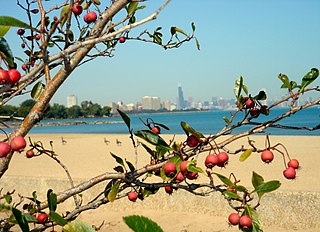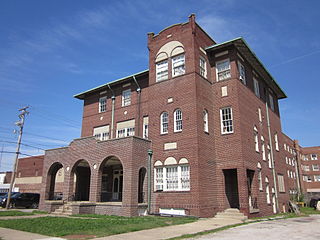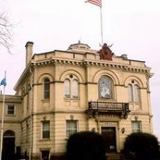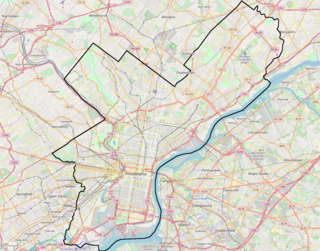
Illinois Institute of Technology is a private research university in Chicago, Illinois. Tracing its history to 1890, the present name was adopted upon the merger of the Armour Institute and Lewis Institute in 1940. The university has programs in architecture, business, communications, design, engineering, industrial technology, information technology, law, psychology, and science. Its historic roots are in several 19th-century engineering and professional education institutions in the United States. In the mid 20th century, it became closely associated with trends in modernist architecture through the work of its Dean of Architecture Ludwig Mies van der Rohe, who designed its campus. The Institute of Design, Chicago-Kent College of Law, and Midwest College of Engineering were also merged into IIT.

South Shore is one of 77 defined community areas of Chicago, Illinois, United States. A predominantly African-American neighborhood on the city's South Side, the area is named for its location along the city's southern lakefront. Although South Shore has seen a greater than 40% decrease in residents since Chicago's population peaked in the 1950s, the area remains one of the most densely populated neighborhoods on the South Side. The community benefits from its location along the waterfront, its accessibility to Lake Shore Drive, and its proximity to major institutions and attractions such as the University of Chicago, the Museum of Science and Industry, and Jackson Park.

Douglas, on the South Side of Chicago, Illinois, is one of 77 Chicago community areas. The neighborhood is named for Stephen A. Douglas, an Illinois politician, whose estate included a tract of land given to the federal government. This tract later was developed for use as the Civil War Union training and prison camp, Camp Douglas, located in what is now the eastern portion of the Douglas neighborhood. Douglas gave that part of his estate at Cottage Grove and 35th to the Old University of Chicago. The Chicago 2016 Olympic bid planned for the Olympic Village to be constructed on a 37-acre (150,000 m2) truck parking lot south of McCormick Place that is mostly in the Douglas community area and partly in the Near South Side.

The Paris Elks Lodge No. 812 Building is a historic building located at 111 E. Washington St. in Paris, Illinois. The building served as a meeting place for the Paris lodge of the Benevolent and Protective Order of Elks. The building was constructed in 1927, 25 years after the Paris Lodge was chartered. Architect Everett Blackman, a member of the lodge, designed the building in the Mediterranean Revival style. Blackman's design features an arcade loggia enclosing the front entrance and a square tower with a parapet roof designed to resemble elk antlers. The building's amenities included a bar and ballroom on the second floor, a bowling alley in the basement, and meeting rooms for the lodge. The third floor of the building housed rooms for the adjacent France Hotel; it was connected to the hotel by a stone walkway and cannot be accessed from the lower floors. The Elks used the building until the lodge filed for bankruptcy in 1978.

Black Metropolis–Bronzeville District is a historic district in the Bronzeville neighborhood of South Side, Chicago, Illinois.

The Willimantic Elks Club is a historic Elks lodge at 198 Pleasant Street in the Willimantic section of Windham, Connecticut. Built in 1925 for a lodge founded in 1914, it is one of the finest examples of Tudor Revival architecture in the region, and has been a major site of social events in the community since. The building was added to the National Register of Historic Places in 2005.

Stolp Island is a small island in the Fox River in Aurora, Illinois. In 1986 the island and its 41 buildings were added to the National Register of Historic Places as the Stolp Island Historic District. It covers 0.03 square miles (0.1 km2) of land area.

The Aurora Elks Lodge No. 705 is a Mayan style building on Stolp Island in Aurora, Illinois. It is included in the Stolp Island Historic District. The building was built in 1926 and was listed on the National Register of Historic Places in 1980.

The B.P.O. Elks Lodge is a historic fraternal lodge building at 34 Prospect Street in Hartford, Connecticut. It is a Classical Revival architecture building designed by John J. Dwyer, and built in 1903 for the local chapter of the Benevolent and Protective Order of Elks. The building was listed on the National Register of Historic Places in 1984 for its architecture.

The Benevolent and Protective Order of Elks Lodge, also known as the Elks Civic Building, is a historic building in Montrose, Colorado, United States. It served as an Elks lodge from construction in 1927 until 1969, and has since housed a college and city offices. In 2017 it was, and in 2019 still is, the location of the city's Visitors' Center. The building is listed on the Colorado State Register of Historic Properties and the National Register of Historic Places.

The Elks Temple in Boise, Idaho was built during 1913-1914 and expanded during 1923-34. It is a four-story, five-bay building in "Italian Palazzo Style". It has served as a clubhouse of the Benevolent and Protective Order of Elks (Elks) organization. It was listed on the National Register of Historic Places in 1978.

The Fort Worth Elks Lodge 124, also known as Benevolent and Protective Order of Elks is an organization founded in 1901, and it is also the name of its five-story building with elements of Georgian Revival architecture and of Spanish Renaissance Revival architecture that was built during 1927-28. It was purchased by the YWCA of Fort Worth and Tarrant County in 1954.

The Elks Club was a historic clubhouse building located at Parkersburg, Wood County, West Virginia. It was designed by architect William Howe Patton and built in 1903. It was a four-story, three-bay by six-bay wide, red brick building with terra cotta trim in the Classical Revival style. The first two stories were faced in smooth dressed stone, and feature arched apertures, with central consoles. It was occupied by the Parkersburg Lodge #198, Benevolent and Protective Order of Elks (B.P.O.E.)

Philadelphia Lodge No. 2 BPOE, also known as the Philadelphia Athletic Club, was a historic Benevolent and Protective Order of Elks (BPOE) lodge occupying 306-320 N. Broad Street in the Logan Square neighborhood of Center City Philadelphia. The lodge, built between 1922 and 1925, was a 13-story building. The BPOE moved into the new lodge from the 4-story building at 1320–1322 Arch Street, built in 1904–1906 and designed by Francis Caldwell and Edward Simon, that still stands.

The Nevada-California-Oregon Railway Co. General Office Building, commonly known as the N.C.O. Building, is a historic site in Alturas, California, listed on the National Register of Historic Places. It was built 1917–1918 to serve as the headquarters of the Nevada-California-Oregon Railway. It has been an Elks Lodge since at least 1974.

Rockford Elk's Lodge #64 is a historic building in Rockford, Illinois, United States originally used by a chapter of the Benevolent and Protective Order of Elks. It is individually listed on the National Register of Historic Places and is also part of the West Downtown Rockford Historic District.

The Centralia Elks Lodge is a historic building located at 328 E. Broadway in Centralia, Illinois. The Classical Revival building was constructed between 1929 and 1931 for Centralia Lodge 493, the city's chapter of the Benevolent and Protective Order of Elks. The entrance to the building is flanked by Ionic columns. The second-story windows on the front facade are topped with limestone pediments and segmented arches; the windowsills feature decorative brackets. Limestone cornices top both stories of the building, and a cartouche bordered by scrolls sits on the roofline above the central front window.

Benevolent and Protective Order of Elks, Lodge Number 878 is a historic Elks lodge located in the Elmhurst neighborhood of Queens, New York. The main building and annex were built in 1923-1924, and is a 3 1/2-story, Italian Renaissance style brick building. A three-story rear addition was added in 1930. The building features a granite-block terrace and granite balustrade, limestone arched entrance, and an elaborate terra cotta cornice. It was once was the largest such lodge in the Eastern United States, with 60 inn rooms, bowling alleys, billiards, a ladies' lounge, and a 50 feet (15 m) bar. The Ballinger Company designed the building, which is made of granite, limestone, and brick. A statue of an elk is located near the Queens Boulevard entrance.

The Yondorf Block and Hall is a historic building at 758 W. North Avenue in the Lincoln Park neighborhood of Chicago, Illinois. The building was built in 1887 to serve as a meeting hall for the various social organizations in Lincoln Park; while its first floor was dedicated to retail space, it had six meeting rooms on its upper floors. Chapters of national fraternal organizations and ethnic clubs formed by immigrants in the neighborhood met in the building, and its largest hall hosted speeches and performances as well. Designed by Frederick Alschlager, the building combines Victorian Gothic and Romanesque Revival elements. While its terra cotta clad storefronts and metal cornice are typical of the former style, its use of decorative brickwork and stone is inspired by the latter.






















